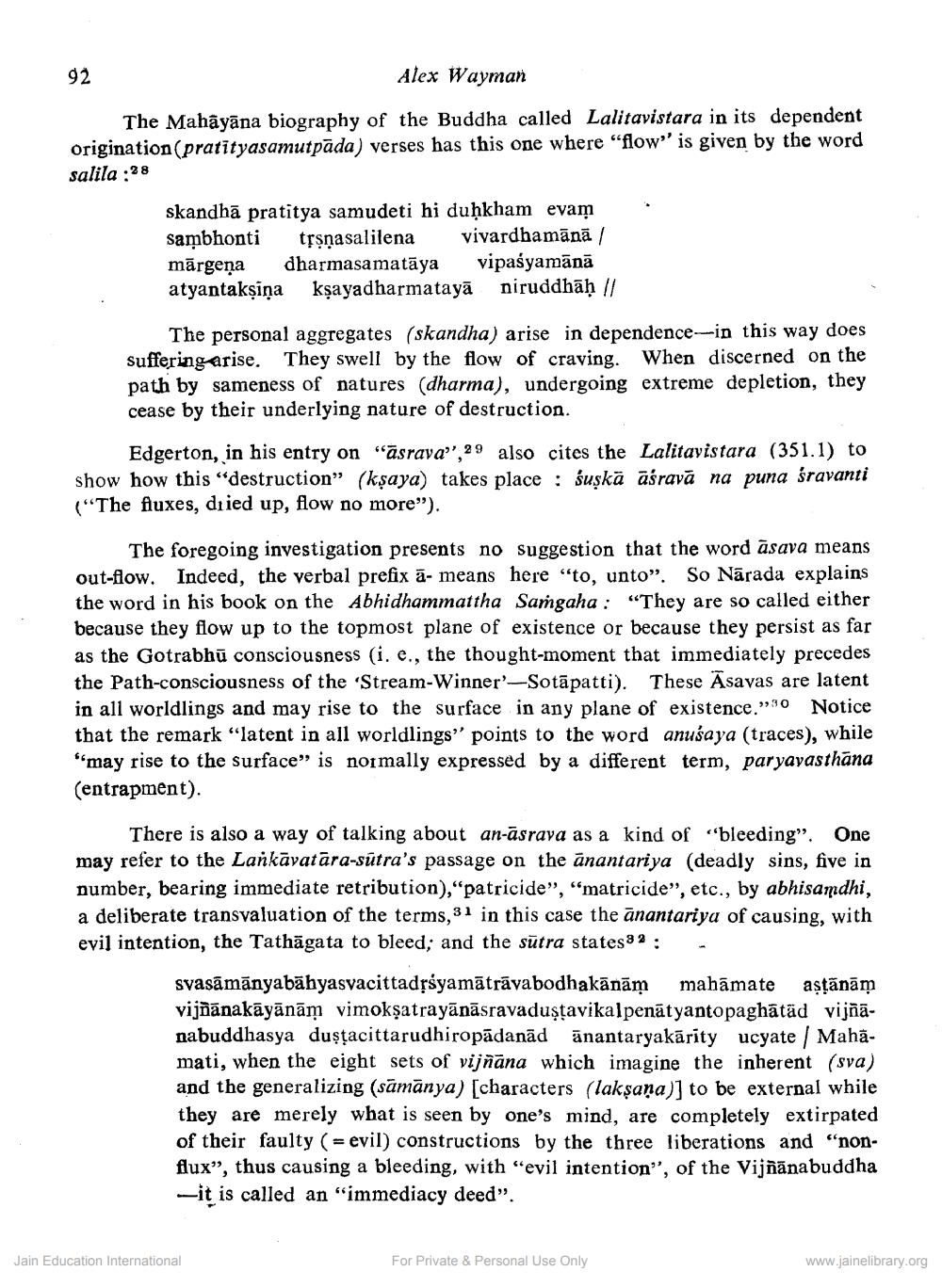Book Title: Asarva how does it flow Author(s): Alex Wayman Publisher: Z_Aspect_of_Jainology_Part_3_Pundit_Dalsukh_Malvaniya_012017.pdf View full book textPage 5
________________ 92 Alex Wayman The Mahāyāna biography of the Buddha called Lalitavistara in its dependent origination (pratityasamutpāda) verses has this one where "flow" is given by the word salila :28 skandhā pratitya samudeti hi duḥkham evam sambhonti trsnasalilena vivardhamānā / mārgeņa dharmasamatāya vipaśyamānā atyantaksiņa kşayadharmatayā niruddhāḥ // The personal aggregates (skandha) arise in dependence in this way does suffering arise. They swell by the flow of craving. When discerned on the path by sameness of natures (dharma), undergoing extreme depletion, they cease by their underlying nature of destruction. Edgerton, in his entry on “äsrava”, 29 also cites the Lalitavistara (351.1) to show how this "destruction” (kşaya) takes place : suskā aśrava na puna śravanti ("The fluxes, dried up, flow no more"). The foregoing investigation presents no suggestion that the word āsava means out-flow. Indeed, the verbal prefix ā- means here "to, unto". So Nārada explains the word in his book on the Abhidhammattha Samgaha : “They are so called either because they flow up to the topmost plane of existence or because they persist as far as the Gotrabhū consciousness (i, e., the thought-moment that immediately precedes the Path-consciousness of the 'Stream-Winner'--Sotāpatti). These Āsavas are latent in all worldlings and may rise to the surface in any plane of existence."0 Notice that the remark "latent in all worldlings'' points to the word anuśaya (traces), while "may rise to the surface” is normally expressed by a different term, paryavasthana (entrapment). There is also a way of talking about an-āsrava as a kind of “bleeding”. One may refer to the Lankāvatāra-sūtra's passage on the anantariya (deadly sins, five in number, bearing immediate retribution),"patricide”, “matricide”, etc., by abhisamdhi, a deliberate transvaluation of the terms, 31 in this case the ānantariya of causing, with evil intention, the Tathāgata to bleed; and the sutra states 32 : - svasāmānyabāhyasvacittadsáyamātrāvabodhakānām mahāmate astānām vijñānakāyānām vimokşatrayānāsravaduşțavikalpenātyantopaghātad vijñānabuddhasya duştacittarudhiropādanād ūnantaryakärity ucyate / Mahāmati, when the eight sets of vijñāna which imagine the inherent (sva) and the generalizing (sāmānya) [characters (laksana)] to be external while they are merely what is seen by one's mind, are completely extirpated of their faulty (= evil) constructions by the three liberations and "nonflux”, thus causing a bleeding, with "evil intention”, of the Vijñānabuddha it is called an "immediacy deed”. Jain Education International For Private & Personal Use Only www.jainelibrary.orgPage Navigation
1 ... 3 4 5 6 7 8
